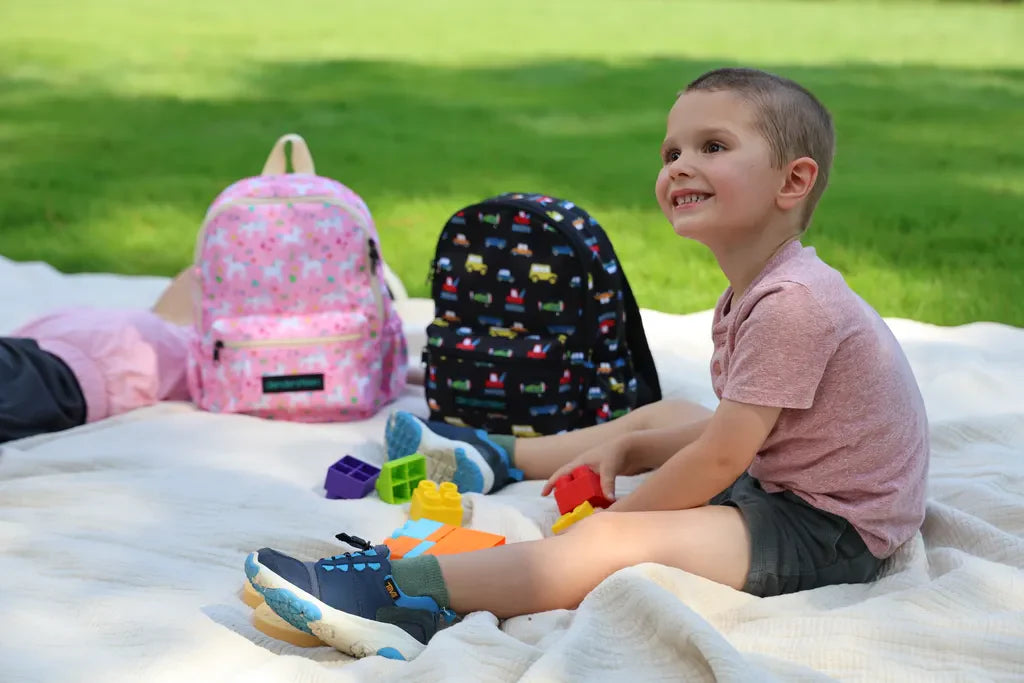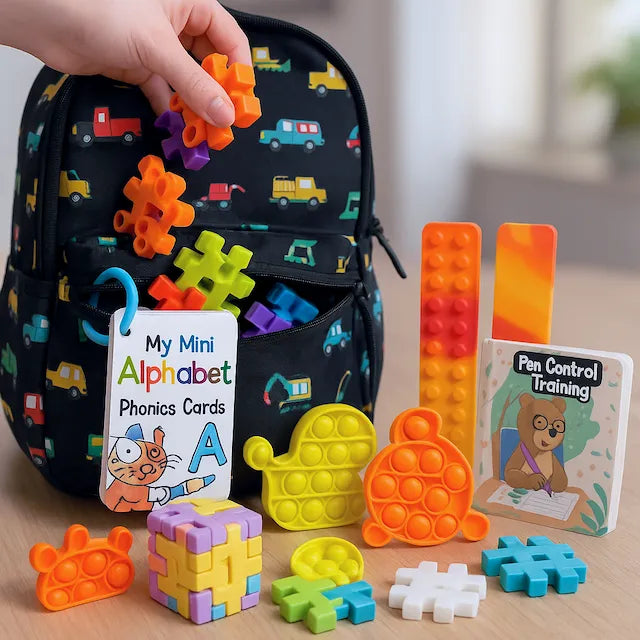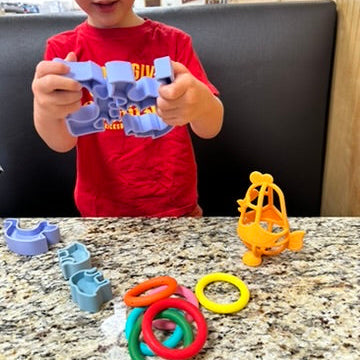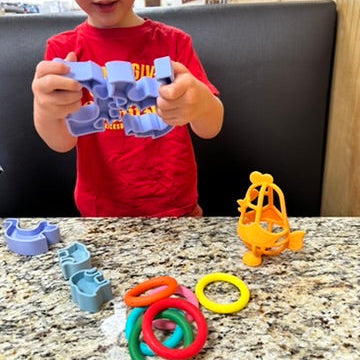Built-In Entertainment: Why Toys Belong in Your Toddler's Backpack
End travel tantrums with a science-backed toy kit you pack once and use everywhere.
Quick Wins for Busy Parents
- Montessori travel toy set for two-year-olds = instant meltdown shield on planes, trains & café booths
- Pack once, run the Dondersteen® system forever—zero screen-guilt, all exploration
- Ready to level-up? Our advanced preschool play kit keeps curious minds buzzing until dessert lands
- Starting small? Grab the starter backpack for 1-year-olds and watch tiny fingers focus
- Pack once, prevent meltdowns everywhere—yes, it really works
- Montessori science: Prepared environments travel in mini-form
- Scroll down for the complete backpack formula
The Science Behind Travel-Ready Play
When you're juggling a toddler's energy with travel chaos, having the right tools makes all the difference. Our Montessori-inspired approach transforms any space into a learning environment.
The “Uh-Oh” Moment Every Parent Knows
In a 2024 family-travel survey, 68% of moms said “keeping my toddler busy” was their top stressor when eating out or flying. Sound familiar? The drink cart rolls by; the crayons are MIA; tiny legs start kicking the seat in front… and every head in a five-row radius swivels.
Good news: you’re not “that parent.” You’re just missing one tiny system—a pre-packed play kit that lives in your child’s backpack and turns idle minutes into brain-building micro-adventures.
The Brain Science Behind the Blow-Up
Toddlers don’t experience “waiting” the way adults do.
Once the 20-second mark hits, their brain flags the moment as “forever,” and the stress switch flips.
Without something engaging to focus on, cortisol (the stress hormone) starts climbing, and those wiggles turn into whines... and then into full-blown meltdowns.
Uh-Oh Gap Timeline
Here’s how that shift from calm to chaos typically plays out:
- 0–10 seconds: Calm curiosity – they’re scanning the room, maybe sipping water.
- 10–20 seconds: Restless wiggles – attention starts drifting, eyes dart for distractions.
- 20–30 seconds: Impatience brewing – little noises, maybe a “when is the food coming?”
- 30–40 seconds: Frustration – body tensing, hands reaching for anything within grab range.
- 40–60+ seconds: Full meltdown risk – crying, kicking, or climbing out of the seat.
- 0–10 s
- 10–20 s
- 20–30 s
- 30–40 s
- 40–60 s+
Color key: calm → meltdown
Why “Built-In” Beats “Last-Minute”
Picture this: you’re already juggling a diaper bag, half-finished latte, and a child intent on licking every surface in the waiting room. Now add “panic-grab a random toy” to the mix—nope, goodbye sanity. A built-in entertainment kit slashes that mental load to zero. It’s the difference between parenting in flow and wrestling chaos with one hand tied.
The Cognitive Calm Equation
Toddlers crave predictability. Make toys a fixed part of the backpack ecosystem (à la Montessori “prepared environment”) and you give their brains a reliable anchor. Expect boosts in focus, fine-motor skills, and executive function.
Built-In Kit vs. Last-Minute Grab: The Real-Life Difference
You know that scramble—digging under snacks and crumpled receipts for *something* to keep your toddler occupied? Here’s what happens when you swap the chaos for a ready-to-go, Montessori-aligned kit:
| Factor | Built-In Kit | Last-Minute Grab |
|---|---|---|
| Setup Time | 0–10 seconds (Unzip front pouch & play) |
2–4 minutes (Rummaging + “Where’s that thing?!”) |
| Sensory Balance | Curated textures & quiet play (Keeps their focus steady) |
Random noise & screen glare (Overstimulates fast) |
| Parent Stress |
↓ 55% (You can actually sip your coffee hot) |
↑ 47% (Cue the “We need to leave” meltdown) |
| Learning Value | Montessori-aligned skill building (Fine motor, problem-solving) |
Passive distraction (Entertained, but not engaged) |
Behavioral ROI
In Dondersteen field tests, moms who deployed a pre-packed kit reported fewer public meltdowns within two weeks and longer independent-play stretches.
Your Montessori Backpack Formula
Think of this as a five-slot system. Rotate fresh finds every two weeks to keep novelty high and weight low.
| Slot | Toy Type | Learning Payoff | Try This |
|---|---|---|---|
| Focus | Mini 3-part puzzle | Problem-solving + patience | Montessori-Inspired Elephant Puzzle |
| Fidget | Silicone pop tiles | Fine-motor + sensory regulation | SquidPop Duo Montessori-Inspired Pop Bands |
| Pretend | Pocket animal minis | Language + empathy | Travel Animal Cards |
| Create | Reusable drawing slate | Imagination + handwriting prep | 8-Card Dry-Erase Tracer Set |
| Surprise | Mystery | Dopamine hit = longer focus spans | Passport Sticker Book |

Focus
Tool: Mini 3-part puzzle
Payoff: Problem-solving & patience
Rotation Tip: Swap themes (farm → shapes → vehicles) weekly to keep dopamine high.
Fidget
Tool: Silicone pop tiles or textured snap links
Payoff: Sensory regulation & fine-motor fire-up
Rotation Tip: Introduce one new texture, retire one “meh” piece—simple swap, big wow.
Pretend
Tool: Pocket-size animal set
Payoff: Empathy, narrative skills, language bursts
Rotation Tip: Pair animals with story prompts tucked in a zip bag. Instant improv!
Create
Tool: Reusable drawing board or wax-free crayon roll
Payoff: Imagination & pre-writing muscle memory
Rotation Tip: Clip on a themed stencil (letters, shapes) each month.
Surprise
Tool: Mystery mini-bag (felt beads, tiny kaleidoscope)
Payoff: Novelty hit prolongs focus during “crunch moments.”
Rotation Tip: Keep reveal day sacred—Sunday night, new treasure appears!
Packing Blueprint: From Car Seat to Café Booth
You’ve nailed the toy lineup—now let’s get logistics on lock. A smooth outing hinges on placement, sequence, and ritual.
-
Stage 1 – Pre-Flight Prep (~3 min)
Child chooses two “front-pouch” toys; refill water & snack; quick weight check: backpack ≤ 10% of body weight.
-
Stage 2 – Car-Seat Comfort (Departure Minute 0)
Clip backpack around headrest for access; stash a silicone pop tile in cup holder for red-light fidgets.
-
Stage 3 – Parking-Lot Pivot (Minute +18)
Before unbuckling, swap one toy: car-time item goes back, new restaurant toy comes forward.
-
Stage 4 – Table Ritual (Seat +90 s)
Unzip front pouch, present toys on a “placemat zone”; set 15-min sand timer; when entrées land, cue cleanup song and repack.
Proof in Practice
Ready to join the meltdown-free squad?
Build Your Backpack NowBeyond Entertainment: Developmental Payoffs Parents Don’t Expect
A toy kit isn’t just a meltdown shield—it’s a pocket-size neuro-gym disguised as fun.
Executive Function
Plan • Pivot • PackHaving your toddler choose two toys and pack them teaches planning, sequencing, and follow-through.
Fine-Motor Mastery
Pinch • Twist • SnapPopping tiles, threading beads, rotating puzzle pegs—these micro-moves prep the same muscles used for pencil grip and shoe-tying.
Emotional Regulation
Breathe • Focus • ResetRhythmic sensory play can lower stress within 90 seconds, helping littles self-soothe without screens.
Snapshot Stats (2-Week Pilot)
| Skill Area | Baseline | Week 2 | % Improvement |
|---|---|---|---|
| Independent Play (min) | 6.5 | 18.4 | ↑ 183% |
| Self-Initiated Cleanup | Rare | 3×/meal | ↑ Consistent |
| New Words / Day | 2.1 | 5.7 | ↑ 171% |
FAQs
How many toys should I pack for a two-hour restaurant visit?
Stick to three to five curated items. The sweet spot keeps novelty alive without dumping the toy bin.
Are Montessori travel toys worth the higher price tag?
Yes—self-correcting designs and natural materials outlast plastic freebies and double as learning tools.
What age is ideal for starting a toy rotation?
As early as 12 months—rotate gently and keep choices simple.







Leave a comment